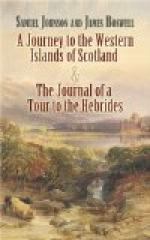At Nairn we may fix the verge of the Highlands; for here I first saw peat fires, and first heard the Erse language. We had no motive to stay longer than to breakfast, and went forward to the house of Mr. Macaulay, the minister who published an account of St. Kilda, and by his direction visited Calder Castle, from which Macbeth drew his second title. It has been formerly a place of strength. The drawbridge is still to be seen, but the moat is now dry. The tower is very ancient: Its walls are of great thickness, arched on the top with stone, and surrounded with battlements. The rest of the house is later, though far from modern.
We were favoured by a gentleman, who lives in the castle, with a letter to one of the officers at Fort George, which being the most regular fortification in the island, well deserves the notice of a traveller, who has never travelled before. We went thither next day, found a very kind reception, were led round the works by a gentleman, who explained the use of every part, and entertained by Sir Eyre Coote, the governour, with such elegance of conversation as left us no attention to the delicacies of his table.
Of Fort George I shall not attempt to give any account. I cannot delineate it scientifically, and a loose and popular description is of use only when the imagination is to be amused. There was every where an appearance of the utmost neatness and regularity. But my suffrage is of little value, because this and Fort Augustus are the only garrisons that I ever saw.
We did not regret the time spent at the fort, though in consequence of our delay we came somewhat late to Inverness, the town which may properly be called the capital of the Highlands. Hither the inhabitants of the inland parts come to be supplied with what they cannot make for themselves: Hither the young nymphs of the mountains and valleys are sent for education, and as far as my observation has reached, are not sent in vain.
INVERNESS
Inverness was the last place which had a regular communication by high roads with the southern counties. All the ways beyond it have, I believe, been made by the soldiers in this century. At Inverness therefore Cromwell, when he subdued Scotland, stationed a garrison, as at the boundary of the Highlands. The soldiers seem to have incorporated afterwards with the inhabitants, and to have peopled the place with an English race; for the language of this town has been long considered as peculiarly elegant.
Here is a castle, called the castle of Macbeth, the walls of which are yet standing. It was no very capacious edifice, but stands upon a rock so high and steep, that I think it was once not accessible, but by the help of ladders, or a bridge. Over against it, on another hill, was a fort built by Cromwell, now totally demolished; for no faction of Scotland loved the name of Cromwell, or had any desire to continue his memory.




